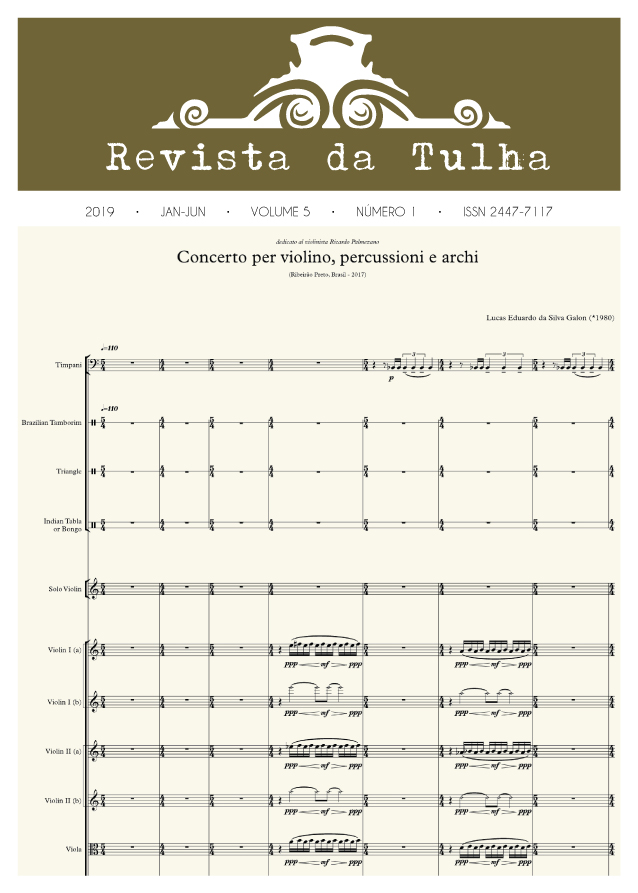Lucas Galon’s Concerto for Violin, Percussion and Strings (2018)
a composer in search of his voice
DOI:
https://doi.org/10.11606/issn.2447-7117.rt.2019.156842Keywords:
Lucas Galon, Samba, Serialism, Second violin concert of Béla BartókAbstract
In this paper, I investigate how the composer searches for his own voice in his violin concerto while using a blend of influences such as Bartok, twelve-tone and Brazilian popular music. Galon argues that composers such as Bartok, Stravinsky and Villa-Lobos followed an independent, more varied compositional style without subscribing to any specific method.[1]On the other hand, the self-proclaimed mainstream of the Second Viennese School established a very structured, particular way of writing music. The composer seems to put into question the mechanization of composition of the dodecaphonic method, but validates its use as a way of refraining his creative impulse.[2]While Bartok’s Violin Concerto No. 2provides a framework for his piece; the tools he uses to manipulate the musical material are drawn from a free use of serialism and Brazilian contemporary music philosophy and aesthetic.
Downloads
References
Appleby, David. The Music of Brazil. Austin, TX: University of Texas Press, 1983.
Bartók, Béla. Concerto for Violin and Orchestra no. 2, Sz. 112.
Béhague, Gerard. "Samba." Grove Music Online. Accessed 17 April, 2018. http://www.oxfordmusiconline.com.proxy.lib.miamioh.edu/grovemusic/view/10.1093/gmo/9781561592630.001.0001/omo-9781561592630-e-0000024449.
Béhague, Gerard. "Brazil." Grove Music Online. 17 Apr. 2018. http://www.oxfordmusiconline.com.proxy.lib.miamioh.edu/grovemusic/view/10.1093/gmo/9781561592630.001.0001/omo-9781561592630-e-0000003894.
Bezerra, Márcio. A Unique Brazilian Composer: a Study of the Music of Gilbero Mendes. Brussels: A. van Kerckhoven, 2003.
Galon, Lucas Eduardo da Silva. “Estética e contemporaneidade: por uma outra filosofia da música nova.” PhD diss., Universidade de São Paulo, 2016.
Griffiths, Paul. "Serialism." Grove Music Online. Accessed 15 May. 2018. http://www.oxfordmusiconline.com.proxy.lib.miamioh.edu/grovemusic/view/10.1093/gmo/9781561592630.001.0001/omo-9781561592630-e-0000025459.
Laki, Péter. "Performance Practice and Philology in Bartók's Violin Concerto (1938)." Studia Musicologica 53, no. 1/3 (2012): 153-59. http://www.jstor.org.proxy.lib.miamioh.edu/stable/23488448.
Livingston, Tamara Elena and Thomas George Caracas Garcia. Choro: A Social History of a Brazilian Popular Music. Bloomington, IN: Indiana University Press, 2005.
Moore, Robin. Musics of Latin America. Austin, TX: University of Texas Press, 2012.
Perez, Vera Lúcia Rocha Pedron. “Postmodern characteristics in the work Rimsky by Brazilian composer Gilberto Mendes.” Per musi 22 (2010): 107-126.
Ramos, Ricely Araújo. “Música viva e a nova fase da modernidade musical brasileira.” In: SIMPÓSIO NACIONAL DE HISTÓRIA, 25., 2009, Fortaleza. Anais do Simpósio Nacional de História – História e Ética. Fortaleza: ANPUH, 2009.
Savil, Roy. “Music in brazil.” Tempo, no. 37 (1995): 31-33.
http://www.jstor.org.proxy.lib.miamioh.edu/stable/943245.
Schenbach, P. J. Classical Music of Brazil. Albuquerque, NM: University of New Mexico, 1984.
Silva, Flavio. “Camargo Guarnieri and the Influence of Mário de Andrade’s Modernism.” Latin American Music Review / Revista De Música Latinoamericana 29, no. 1 (2008): 43-63.
Straus, Joseph Nathan. Introduction to Post-tonal Theory. New York: W.W. Norton & Company, 2016.
Downloads
Published
Issue
Section
License
Copyright (c) 2019 Ricardo Alex Palmezano

This work is licensed under a Creative Commons Attribution 4.0 International License.
Authors retain copyright and grant the journal the right to first publication, with the work licensed under the Creative Commons Attribution License CC-BY-NC:
This work is licensed under a Creative Commons Attribution 4.0 International License.



